[English] 日本語
 Yorodumi
Yorodumi- PDB-6um6: Cryo-EM structure of HIV-1 neutralizing antibody DH270.6 in compl... -
+ Open data
Open data
- Basic information
Basic information
| Entry | Database: PDB / ID: 6um6 | |||||||||
|---|---|---|---|---|---|---|---|---|---|---|
| Title | Cryo-EM structure of HIV-1 neutralizing antibody DH270.6 in complex with CH848 10.17DT Env | |||||||||
 Components Components |
| |||||||||
 Keywords Keywords | VIRAL PROTEIN/immune system / V3-glycan site / unmutated common ancestor / DH270 lineage / VIRAL PROTEIN / VIRAL PROTEIN-immune system complex | |||||||||
| Function / homology |  Function and homology information Function and homology informationsymbiont-mediated perturbation of host defense response / positive regulation of plasma membrane raft polarization / positive regulation of receptor clustering / host cell endosome membrane / clathrin-dependent endocytosis of virus by host cell / viral protein processing / fusion of virus membrane with host plasma membrane / fusion of virus membrane with host endosome membrane / viral envelope / virion attachment to host cell ...symbiont-mediated perturbation of host defense response / positive regulation of plasma membrane raft polarization / positive regulation of receptor clustering / host cell endosome membrane / clathrin-dependent endocytosis of virus by host cell / viral protein processing / fusion of virus membrane with host plasma membrane / fusion of virus membrane with host endosome membrane / viral envelope / virion attachment to host cell / host cell plasma membrane / virion membrane / structural molecule activity / membrane Similarity search - Function | |||||||||
| Biological species |   Human immunodeficiency virus 1 Human immunodeficiency virus 1 Homo sapiens (human) Homo sapiens (human) | |||||||||
| Method | ELECTRON MICROSCOPY / single particle reconstruction / cryo EM / Resolution: 4.3 Å | |||||||||
 Authors Authors | Acharya, P. / Henderson, R.C. / Saunder, K.O. / Haynes, B.F. | |||||||||
| Funding support |  United States, 2items United States, 2items
| |||||||||
 Citation Citation |  Journal: Science / Year: 2019 Journal: Science / Year: 2019Title: Targeted selection of HIV-specific antibody mutations by engineering B cell maturation. Authors: Kevin O Saunders / Kevin Wiehe / Ming Tian / Priyamvada Acharya / Todd Bradley / S Munir Alam / Eden P Go / Richard Scearce / Laura Sutherland / Rory Henderson / Allen L Hsu / Mario J ...Authors: Kevin O Saunders / Kevin Wiehe / Ming Tian / Priyamvada Acharya / Todd Bradley / S Munir Alam / Eden P Go / Richard Scearce / Laura Sutherland / Rory Henderson / Allen L Hsu / Mario J Borgnia / Haiyan Chen / Xiaozhi Lu / Nelson R Wu / Brian Watts / Chuancang Jiang / David Easterhoff / Hwei-Ling Cheng / Kelly McGovern / Peyton Waddicor / Aimee Chapdelaine-Williams / Amanda Eaton / Jinsong Zhang / Wes Rountree / Laurent Verkoczy / Mark Tomai / Mark G Lewis / Heather R Desaire / Robert J Edwards / Derek W Cain / Mattia Bonsignori / David Montefiori / Frederick W Alt / Barton F Haynes /  Abstract: INTRODUCTION: A major goal of HIV-1 vaccine development is the design of immunogens that induce broadly neutralizing antibodies (bnAbs). However, vaccination of humans has not resulted in the ...INTRODUCTION: A major goal of HIV-1 vaccine development is the design of immunogens that induce broadly neutralizing antibodies (bnAbs). However, vaccination of humans has not resulted in the induction of affinity-matured and potent HIV-1 bnAbs. To devise effective vaccine strategies, we previously determined the maturation pathway of select HIV-1 bnAbs from acute infection through neutralizing antibody development. During their evolution, bnAbs acquire an abundance of improbable amino acid substitutions as a result of nucleotide mutations at variable region sequences rarely targeted by activation-induced cytidine deaminase, the enzyme responsible for antibody mutation. A subset of improbable mutations is essential for broad neutralization activity, and their acquisition represents a key roadblock to bnAb development. RATIONALE: Current bnAb lineage-based vaccine strategies can initiate bnAb lineage development in animal models but have not specifically elicited the improbable mutations required for neutralization ...RATIONALE: Current bnAb lineage-based vaccine strategies can initiate bnAb lineage development in animal models but have not specifically elicited the improbable mutations required for neutralization breadth. Induction of bnAbs requires vaccine strategies that specifically engage bnAb precursors and subsequently select for improbable mutations required for broadly neutralizing activity. We hypothesized that vaccination with immunogens that bind with moderate to high affinity to bnAb B cell precursors, and with higher affinity to precursors that have acquired improbable mutations, could initiate bnAb B cell lineages and select for key improbable mutations required for bnAb development. RESULTS: We elicited serum neutralizing HIV-1 antibodies in human bnAb precursor knock-in mice and wild-type macaques vaccinated with immunogens designed to select for improbable mutations. We ...RESULTS: We elicited serum neutralizing HIV-1 antibodies in human bnAb precursor knock-in mice and wild-type macaques vaccinated with immunogens designed to select for improbable mutations. We designed two HIV-1 envelope immunogens that bound precursor B cells of either a CD4 binding site or V3-glycan bnAb lineage. In vitro, these immunogens bound more strongly to bnAb precursors once the precursor acquired the desired improbable mutations. Vaccination of macaques with the CD4 binding site–targeting immunogen induced CD4 binding site serum neutralizing antibodies. Antibody sequences elicited in human bnAb precursor knock-in mice encoded functional improbable mutations critical for bnAb development. In bnAb precursor knock-in mice, we isolated a vaccine-elicited monoclonal antibody bearing functional improbable mutations that was capable of neutralizing multiple HIV-1 global isolates. Structures of a bnAb precursor, a bnAb, and the vaccine-elicited antibody revealed the precise roles that acquired improbable mutations played in recognizing the HIV-1 envelope. Thus, our immunogens elicited antibody responses in macaques and knock-in mice that exhibited the mutational patterns, structural characteristics, or neutralization profiles of nascent broadly neutralizing antibodies. CONCLUSION: Our study represents a proof of concept for targeted selection of improbable mutations to guide antibody affinity maturation. Moreover, this study demonstrates a rational strategy for ...CONCLUSION: Our study represents a proof of concept for targeted selection of improbable mutations to guide antibody affinity maturation. Moreover, this study demonstrates a rational strategy for sequential immunogen design to circumvent the difficult roadblocks in HIV-1 bnAb induction by vaccination. We show that immunogens should exhibit differences in affinity across antibody maturation stages where improbable mutations are necessary for the desired antibody function. This strategy of selection of specific antibody nucleotides by immunogen design can be applied to B cell lineages targeting other pathogens where guided affinity maturation is needed for a protective antibody response. | |||||||||
| History |
|
- Structure visualization
Structure visualization
| Movie |
 Movie viewer Movie viewer |
|---|---|
| Structure viewer | Molecule:  Molmil Molmil Jmol/JSmol Jmol/JSmol |
- Downloads & links
Downloads & links
- Download
Download
| PDBx/mmCIF format |  6um6.cif.gz 6um6.cif.gz | 472.2 KB | Display |  PDBx/mmCIF format PDBx/mmCIF format |
|---|---|---|---|---|
| PDB format |  pdb6um6.ent.gz pdb6um6.ent.gz | 377.9 KB | Display |  PDB format PDB format |
| PDBx/mmJSON format |  6um6.json.gz 6um6.json.gz | Tree view |  PDBx/mmJSON format PDBx/mmJSON format | |
| Others |  Other downloads Other downloads |
-Validation report
| Summary document |  6um6_validation.pdf.gz 6um6_validation.pdf.gz | 1.9 MB | Display |  wwPDB validaton report wwPDB validaton report |
|---|---|---|---|---|
| Full document |  6um6_full_validation.pdf.gz 6um6_full_validation.pdf.gz | 2 MB | Display | |
| Data in XML |  6um6_validation.xml.gz 6um6_validation.xml.gz | 78.2 KB | Display | |
| Data in CIF |  6um6_validation.cif.gz 6um6_validation.cif.gz | 115.1 KB | Display | |
| Arichive directory |  https://data.pdbj.org/pub/pdb/validation_reports/um/6um6 https://data.pdbj.org/pub/pdb/validation_reports/um/6um6 ftp://data.pdbj.org/pub/pdb/validation_reports/um/6um6 ftp://data.pdbj.org/pub/pdb/validation_reports/um/6um6 | HTTPS FTP |
-Related structure data
| Related structure data |  20818MC  6um5C  6um7C M: map data used to model this data C: citing same article ( |
|---|---|
| Similar structure data |
- Links
Links
- Assembly
Assembly
| Deposited unit | 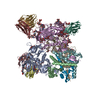
|
|---|---|
| 1 |
|
- Components
Components
-CH848 10.17DT ... , 2 types, 6 molecules AEIBFJ
| #1: Protein | Mass: 51736.535 Da / Num. of mol.: 3 Source method: isolated from a genetically manipulated source Source: (gene. exp.)   Human immunodeficiency virus 1 / Gene: env / Production host: Human immunodeficiency virus 1 / Gene: env / Production host:  Homo sapiens (human) / References: UniProt: A0A1W6IPB2 Homo sapiens (human) / References: UniProt: A0A1W6IPB2#2: Protein | Mass: 18245.830 Da / Num. of mol.: 3 Source method: isolated from a genetically manipulated source Source: (gene. exp.)   Human immunodeficiency virus 1 / Gene: env / Production host: Human immunodeficiency virus 1 / Gene: env / Production host:  Homo sapiens (human) / References: UniProt: Q2N0S7 Homo sapiens (human) / References: UniProt: Q2N0S7 |
|---|
-Antibody , 2 types, 6 molecules CGKDHL
| #3: Antibody | Mass: 25895.893 Da / Num. of mol.: 3 Source method: isolated from a genetically manipulated source Source: (gene. exp.)  Homo sapiens (human) / Production host: Homo sapiens (human) / Production host:  Homo sapiens (human) Homo sapiens (human)#4: Antibody | Mass: 22783.273 Da / Num. of mol.: 3 Source method: isolated from a genetically manipulated source Source: (gene. exp.)  Homo sapiens (human) / Production host: Homo sapiens (human) / Production host:  Homo sapiens (human) Homo sapiens (human) |
|---|
-Sugars , 6 types, 33 molecules 
| #5: Polysaccharide | Source method: isolated from a genetically manipulated source #6: Polysaccharide | Source method: isolated from a genetically manipulated source #7: Polysaccharide | Source method: isolated from a genetically manipulated source #8: Polysaccharide | Source method: isolated from a genetically manipulated source #9: Polysaccharide | Source method: isolated from a genetically manipulated source #10: Sugar | ChemComp-NAG / |
|---|
-Details
| Has ligand of interest | N |
|---|---|
| Has protein modification | Y |
-Experimental details
-Experiment
| Experiment | Method: ELECTRON MICROSCOPY |
|---|---|
| EM experiment | Aggregation state: PARTICLE / 3D reconstruction method: single particle reconstruction |
- Sample preparation
Sample preparation
| Component | Name: Complex of antibody DH270.6 with HIV-1 Env CH848 10.17DT Type: COMPLEX / Entity ID: #2-#4, #1 / Source: MULTIPLE SOURCES |
|---|---|
| Molecular weight | Value: 0.36 MDa / Experimental value: YES |
| Source (natural) | Organism:   Human immunodeficiency virus 1 Human immunodeficiency virus 1 |
| Source (recombinant) | Organism:  Homo sapiens (human) Homo sapiens (human) |
| Buffer solution | pH: 7.2 |
| Specimen | Embedding applied: NO / Shadowing applied: NO / Staining applied: NO / Vitrification applied: YES |
| Vitrification | Cryogen name: ETHANE |
- Electron microscopy imaging
Electron microscopy imaging
| Experimental equipment |  Model: Titan Krios / Image courtesy: FEI Company |
|---|---|
| Microscopy | Model: FEI TITAN KRIOS |
| Electron gun | Electron source:  FIELD EMISSION GUN / Accelerating voltage: 300 kV / Illumination mode: FLOOD BEAM FIELD EMISSION GUN / Accelerating voltage: 300 kV / Illumination mode: FLOOD BEAM |
| Electron lens | Mode: BRIGHT FIELD |
| Image recording | Electron dose: 42 e/Å2 / Film or detector model: FEI FALCON III (4k x 4k) |
- Processing
Processing
| CTF correction | Type: PHASE FLIPPING AND AMPLITUDE CORRECTION |
|---|---|
| Symmetry | Point symmetry: C3 (3 fold cyclic) |
| 3D reconstruction | Resolution: 4.3 Å / Resolution method: FSC 0.143 CUT-OFF / Num. of particles: 107646 / Symmetry type: POINT |
| Refinement | Highest resolution: 4.3 Å |
 Movie
Movie Controller
Controller




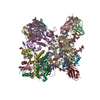
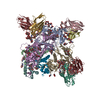
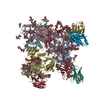
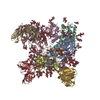


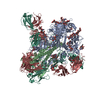

 PDBj
PDBj





